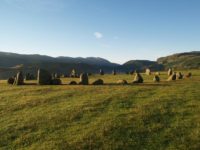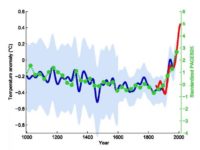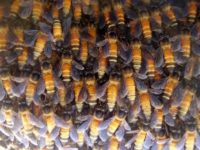By Creation Moments “The evolution of the amniotic egg was key to vertebrates leaving the oceans and colonizing the land and air.” So claimed a recent article on the evolution of the egg. The article noted that there are different shaped eggs among birds. Researchers conducted a statistical study of the eggs produced by 1,400 species of bird. read more …read more Source: Creation Moments
By Creation Moments It was, they say, the “Great Dying” supposedly 250 million years ago. 57% of all land-dwelling vertebrates became extinct. Yet amidst the death and destruction of this event, a new group of animals arose. We call them the dinosaurs. read more …read more Source: Creation Moments
By Creation Moments If you fire a beam of laser light at the Moon, how long will it take to get there? At first, some might suggest that this is a relatively easy problem. Speed equals distance divided by time, so surely we can calculate how long the light will take. But do we really know how fast the light travels from Earth to Moon? Creationist astrophysicist Dr. Jason Lisle suggests that we don’t. read more …read more Source: Creation Moments
By Creation Moments One of the most persistent rumors of popular evolutionary mythology is the concept of a primitive Stone Age. While serious evolutionists do not view such a time in the same way as the popular thinking, particularly in the media, the idea that there were early human societies that had no technology, save the ability to use rocks, is deeply ingrained. read more …read more Source: Creation Moments
By kpennock On this episode of ID The Future, host Tod Butterfield talks with Discovery Senior Fellow Wesley J. Smith about the use and abuse of Preimplantation Genetic Diagnosis (PGD) in China. Smith delves into the initially humane reasons for PGD, but notes how PGD is being used to advance the dark agenda of eugenics. Smith argues that the international community needs to take a leading role in defending the dignity of all human life. Otherwise, he says, China—with its abhorrent record on human rights—may set the standard for the rest of the world. Your browser does not support playing [More]
By Creation Moments We have talked before about Cain and Abel, and we have seen how Cain’s offering was rejected because it was his attempt to get right with God by his own power. We have also seen how Abel’s offering was acceptable because it was the necessary blood sacrifice to atone for sin. read more …read more Source: Creation Moments
By kpennock On this episode of ID the Future, Dr. David Berlinski continues his exploration of cladistics and the Cambrian explosion. Listen in as Berlinski explains the limitations of cladistic analysis and looks at some specifics of Nick Matzke’s critique of Darwin’s Doubt. Your browser does not support playing Audio, please upgrade your browser or find our podcast on podOmatic Download Episode …read more Source: id the future
By Creation Moments Evolutionists assume that evolution happens by increases in genetic information. This, they claim, happens by mutations making more information. We should analyze how this might happen. read more …read more Source: Creation Moments
By Creation Moments Recently, I took a group of 6th Grade children and their teachers around the Hummocks’ Trail as part of their homeschool co-op’s fieldtrip to the area near the Mount St. Helen volcano. It was a hot sunny day. The slopes of many of the hummocks were covered in wild strawberries. The heady scent was strong and delicious in the air! read more …read more Source: Creation Moments
By Creation Moments As Christians, and especially as Christian parents, many of us have negative comments to make about what happens in school science lessons. In so many areas, it is often easier to criticize and break down than to build up something new. Many years ago, I came across a fascinating yet simple curriculum model idea that would be of considerable help in many Christian education situations. read more …read more Source: Creation Moments
By Creation Moments The world’s most infamous hockey stick was probably the graph produced for the Intergovernmental Panel on Climate Change in 1998. The purpose of the graph was to show how global temperatures had changed over time and what had caused these changes. Over the last millennium, the graph showed a steady but gentle increase in temperature until about 1900 when the graph showed a sharp increase. read more …read more Source: Creation Moments
By Sarah Chaffee On this episode of ID the Future, Casey Luskin continues his talk with Dr. Wolf-Ekkehard Lönnig, a retired biologist at the Max Planck Institute for Plant Breeding Research in Germany. Tune in as Dr. Lönnig discusses the origin and biology of carnivorous plants, and how evolutionary theory offers no clear explanation for the unique features of these plants. Your browser does not support playing Audio, please upgrade your browser or find our podcast on podOmatic Download Episode …read more Source: id the future
By Sarah Chaffee On this episode of ID the Future, CSC Senior Fellow Dr. David Berlinski talks about his views on the debate over Darwinian evolution and intelligent design. Berlinski discusses the “almost reflexive dogmatic reaction” of the Darwin community to Stephen Meyer’s argument for intelligent design in Darwin’s Doubt, and explains why cladistic analysis doesn’t solve the Cambrian mystery Your browser does not support playing Audio, please upgrade your browser or find our podcast on podOmatic Download Episode …read more Source: id the future
By kpennock On this episode of ID The Future, we bring you a clip from the documentary Privileged Species a clip arguing that water possesses many unique properties that appear finely tuned to allow for life on Earth. The excerpt dips a toe into what biologist Michael Denton explores in much greater depth in his latest book, The Wonder of Water. Your browser does not support playing Audio, please upgrade your browser or find our podcast on podOmatic Download Episode …read more Source: id the future
By Sarah Chaffee On this episode of ID the Future, Ray Bohlin and Michael Behe discuss the limits of evolution. Does evolution innovative by building things, or does it only innovate by breaking things? Behe demonstrates the surprising answer with a closer look at polar bears. Behe is the subject of an engaging science documentary now available online: Revolutionary. Your browser does not support playing Audio, please upgrade your browser or find our podcast on podOmatic Download Episode …read more Source: id the future
By kpennock On this episode of ID The Future, Robert Crowther talks with paleontologist Dr. Günter Bechly about his entry on Wikipedia which was created in 2012 and suspiciously disappeared in 2015 when he started supporting Intelligent Design. An eminent paleontologist, Bechly was curator of the State Museum of Natural History in Stuttgart, Germany and had numerous species as well as even a family named after him, a high honor in the field. Crowther and Bechly go over the specious reasons given by Wikipedia for Bechly’s deletion, revealing the ideological and authoritarian nature of some the editors at Wikipedia. Your [More]
By Creation Moments I am a long-time fan of the BBC science fiction show Doctor Who, having watched it since the mid-1960s when the show was in black and white with no computer graphics and Daleks were upturned trash cans with sink plungers attached. One of my favorite episodes of the modern era was entitled Dinosaurs on a Spaceship. The title said it all. read more …read more Source: Creation Moments
By Creation Moments Logic can sometimes be a little difficult to follow without seeing pictures. But if we take this carefully, it should make sense. There is a type of logical sequence called a syllogism, where two premises are made, followed by a conclusion. The conclusion should be based on those premises. For example: Premise 1: If it is raining, the streets are wet. Premise 2: It is raining. read more …read more Source: Creation Moments
By Creation Moments When I was in my twenties, I had a friend whose father, Peter, kept bees. One day, he invited me to help collect honey. I was fascinated by the paraphernalia that goes with this activity – the costume, the hood, the smoker, and the hives. Peter had ten hives. His bees were very distinctive. They had a deep brown abdomen with a single yellow stripe across the middle of it. read more …read more Source: Creation Moments
By Creation Moments “You can’t possibly believe that there was a worldwide Flood. If the Ark was floating above Mount Everest, the air would be so thin that they would not be able to breathe.” This objection to the Flood is a very common one that I hear frequently. It is also one that is most easily disproved. In fact, I am always very surprised that so many people think this must be a valid argument. read more …read more Source: Creation Moments
By Creation Moments Evolutionists often use a language all of their own. Frequently that language involves reification. Reification is a logical fallacy whereby an abstract concept is treated as if it were something real or concrete. Evolutionists frequently refer to selection of genetic information by nature – the so-called Natural Selection. Nature is an abstract concept. read more …read more Source: Creation Moments
By kpennock An accountant wonders how people can separate fact from faith in scientific claims, and biologist Jonathan Wells (author of Zombie Science) and playwright Matt Chait respond. This conversation was taped live in Hollywood during a discussion after the final performance of Disinherit the Wind, a play that tells the story of a neurobiologist who sues his university for the right to challenge neo-Darwinian evolution. Your browser does not support playing Audio, please upgrade your browser or find our podcast on podOmatic Download Episode …read more Source: id the future
By kpennock On this episode of ID The Future, Sarah Chaffee talks with bioethicist Wesley Smith about the gene-editing technique known as CRISPR. Smith describes it briefly and discusses its larger implication for bioethics. Your browser does not support playing Audio, please upgrade your browser or find our podcast on podOmatic Download Episode …read more Source: id the future
By Creation Moments Forestry organizations have a major problem with beetles. The Mountain Pine beetle infests many coniferous trees in the Western United States. Apparently 40 million acres of forest have been damaged by these critters. A fungus can get into the tree with the beetle, and this fungus prevents transportation of water and nutrients. The beetle lays its eggs in the bark, and beetle larvae can also cause the tree to die. read more …read more Source: Creation Moments
By Creation Moments Many people know about the devastating and explosive eruption of Mount St Helens in 1980. Not so many people know that the volcano has erupted since then, but in less spectacular fashion. read more …read more Source: Creation Moments
By Sarah Chaffee On this episode of ID the Future, learn about some of scientists’ attempts to copy sophisticated designs found in the natural world. This emerging science of imitating nature, known as biomimetics, has attracted extensive research and led to new technologies. As uniform experience has shown, such good design comes not from blind processes, but from a good mind. Your browser does not support playing Audio, please upgrade your browser or find our podcast on podOmatic Download Episode …read more Source: id the future
By Creation Moments I was on an open-topped tour bus, seeing the sights of downtown Edinburgh—the capital city of Scotland. From this vantage point, our guide stopped frequently, to tell us about John Knox’s grave and house, the Royal Mile, and beautiful Edinburgh Castle. At one stop, there were three things to see. To our left was Britain’s ugliest building—the Scottish Parliament. read more …read more Source: Creation Moments

































